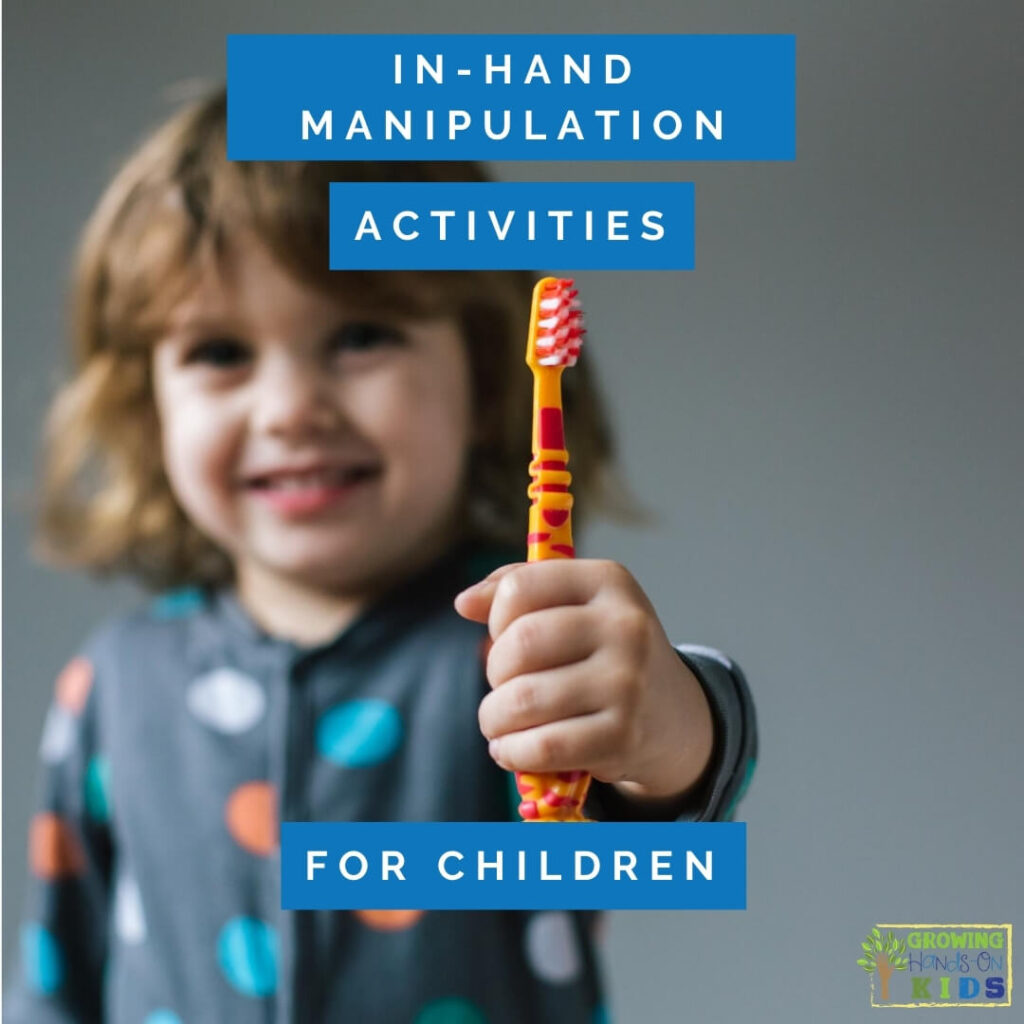Finger Dexterity Activities for Kids
Affiliate and Referral links are used below to promote products I love and recommend. I receive a commission on any purchases made through these links. Please see my disclosure policy for more details. As an Amazon Associate, I earn from qualifying purchases.
Finger dexterity activities are designed to help kids improve their ability to handle small objects. Here are my favorite activities to help improve finger dexterity with kids.
Table of contents for finger dexterity
What is finger dexterity?
Finger dexterity is the ability to control and move the fingers to complete small movements for different fine motor activities. You may also see it referred to as in-hand manipulation skills.
There are around 34 muscles in the hand that all work together with the primary motor cortex located in the dorsal, or upper side and back, of the frontal lobe of the brain.
Finger dexterity is involved with activities such as holding and moving a pencil for handwriting, holding and opening/closing scissors for cutting tasks, manipulating zippers and buttons for self-care tasks, opening and closing jars and lids for containers for daily tasks, or playing musical instruments like the piano and violin, etc.
The skills needed for good finger dexterity include:
Body awareness: knowing where the fingers are in relation to the task and how to move them appropriately, including how much pressure to put through them
Sensory processing: understanding and interpreting sensory input correctly and being able to coordinate a response through the body
Posture: being able to sit with good posture, which puts the shoulders and arms in a good position in order to coordinate the movement of the hands and fingers to complete a task
Shoulder stability: being able to hold the shoulders steady in order for the arm, forearm, elbows, and hands to complete tasks.
Finger dexterity challenges
Children who struggle with finger dexterity may have challenges completing tasks such as:
- Holding a pencil for handwriting
- Using scissors for cutting activities
- Use their whole hand to manipulate objects instead of just their fingers (using the palms of the hand instead of their thumb and fingers)
- Difficulty completing self-care tasks such as buttoning, zipping, etc.
- Difficulty opening and closing containers
These challenges can occur for a variety of reasons including developmental coordination disorder (DCD) and dyspraxia.
Occupational therapy and coordination challenges
Occupational Therapy practitioners will often address any fine motor challenges a child is having. In regards to finger dexterity and in-hand manipulation, the 12-hole peg test can be used to evaluate this skill. The child is asked to take each peg out of the hole, flip it, and re-insert it back into the hole as fast as they can.
Occupational therapists can also help address any underlying skills that may be causing the finger dexterity issue such as sensory processing, body awareness, posture, shoulder stability, hand strength, or any fine motor and self-care challenges.
If you do suspect your child is having challenges with fine motor skills, be sure to ask for an Occupational therapy evaluation referral from their doctor.
How can I improve my child's finger dexterity?
Finger warm-ups and providing lots of opportunities for fine motor activities are great ways to improve your child's finger dexterity. If a child struggles with any of the underlying skills I mentioned above like body awareness, sensory processing, posture, and shoulder stability, these will also impact their ability to complete fine motor activities.
Let's take a look at some of those ideas below.
Finger dexterity exercises for kids
I have a post on handwriting warm-up exercises and some of these activities make perfect finger dexterity exercises for children.
These first two will get the shoulders and arms loosened up and ready for movement.
Crocodile Movement/Snaps
Raise your arms in the air with one above the other. Then snap your hands together like a crocodile snapping its jaw. Take turns having the left and right arms above each other for this activity.
Butterflies
Begin with your arms straightened in front of your body. Like your thumbs together to make an “X” and turn your hands facing out. Using the shoulders to move, make small circles with the hands, moving from left to right (remember to do this movement from the shoulders, not the fingers or hand).
Now let's move on to the fingers.
Finger Push-Ups
Place the tips of your fingers together and straighten the fingers while pushing the fingertips against each other.
Piano Fingers
Drum your fingers on the table or desk as if playing the piano. Make sure each finger touches the desk. You can also work on fast vs. slow movements with this. “How slowly can you play the piano?” “How fast can you play the piano?” “Can you use both hands together to play the piano?”
Pencil Twirls
Get your pencils out and start to twirl them in the air like a baton, spinning them both horizontally and vertically in the air. This combines some shoulder and finger exercises together.
Inchworm
Make sure your child is holding the pencil with an appropriate grasp like the tripod or quadruped grasp. Move your fingers along the pencil from tip to tip, starting at the bottom and working toward the top. Then back down to the bottom of the pencil. Make sure you are only using your writing hand for this one, do not help out with the opposite hand.
Once your kids get the hang of these activities it should only take you 5-10 minutes at the most to complete them all. Then their muscles will be all warmed up and ready for handwriting.
Finger dexterity activities for kids
Here are some specific activities you can do to help improve your child's finger dexterity and in-hand manipulation skills.
- Press cookie cutters into dough or putty
- Play with finger puppets
- Screw and unscrew small lids or nuts and bolts
- Fold paper (i.e. origami, airplanes, etc.)
- Hold a handful of marbles, transferring one at a time into a container
- Draw shapes and write words in a variety of mediums (i.e. shaving cream, sand, finger paint, hair gel in a baggie, etc.)
- Draw designs on an Etch-a-Sketch board
- Use fingers to sprinkle toppings on food (i.e. sprinkles, shredded cheese, etc.)
- Lace beads on a string
- Complete knitting or crocheting projects
- Make bracelets or jewelry
- Place coins into a container or piggy bank
- Finger painting projects
- Learn to play the piano
- Build with building blocks
- Sort objects by size, color, shape, etc.
Finger dexterity games for children
There are a lot of great games that help with in-hand manipulation and finger dexterity. Some of these include:
- Jenga
- Card games
- Connect 4
- Trouble
- Chinese checkers
- Chess
- Winning Fingers Shape Toy Puzzle Game
- Brain teaser puzzle game
- Color peg board
- Finger popper fidget toy
- Wooden Geoboard
- Stringy Majiggy Cats Cradle – Chinese String Toys
References:
Problems with Coordination – Child Mind Institute
Naito E, Morita T, Asada M. Importance of the Primary Motor Cortex in Development of Human Hand/Finger Dexterity. Cereb Cortex Commun. 2020 Dec 2;1(1):tgaa085. doi: 10.1093/texcom/tgaa085. PMID: 34296141; PMCID: PMC8152843.
Nishi Y, Nobusako S, Tsujimoto T, Sakai A, Nakai A, Morioka S. Spatial Instability during Precision Grip-Lift in Children with Poor Manual Dexterity. Brain Sci. 2022 May 4;12(5):598. doi: 10.3390/brainsci12050598. PMID: 35624985; PMCID: PMC9139501.
You May Also Like:

Heather Greutman, COTA
Heather Greutman is a Certified Occupational Therapy Assistant with experience in school-based OT services for preschool through high school. She uses her background to share child development tips, tools, and strategies for parents, educators, and therapists. She is the author of many ebooks including The Basics of Fine Motor Skills, and Basics of Pre-Writing Skills, and co-author of Sensory Processing Explained: A Handbook for Parents and Educators.



I agree with Megan I would love to have a printable version to give to families and collogues.
Is this available in a printable version? Thanks! It is sooo helpful!